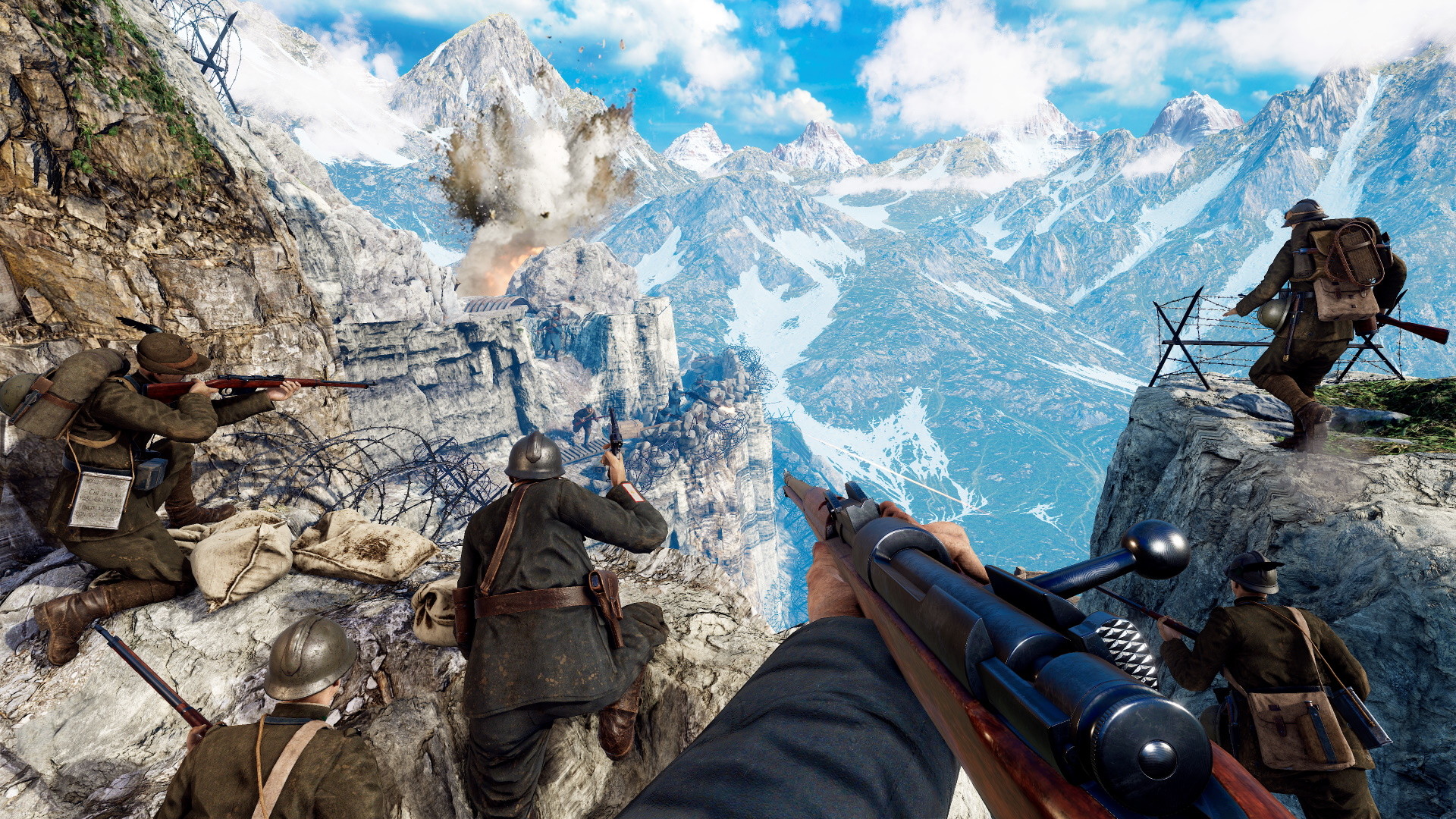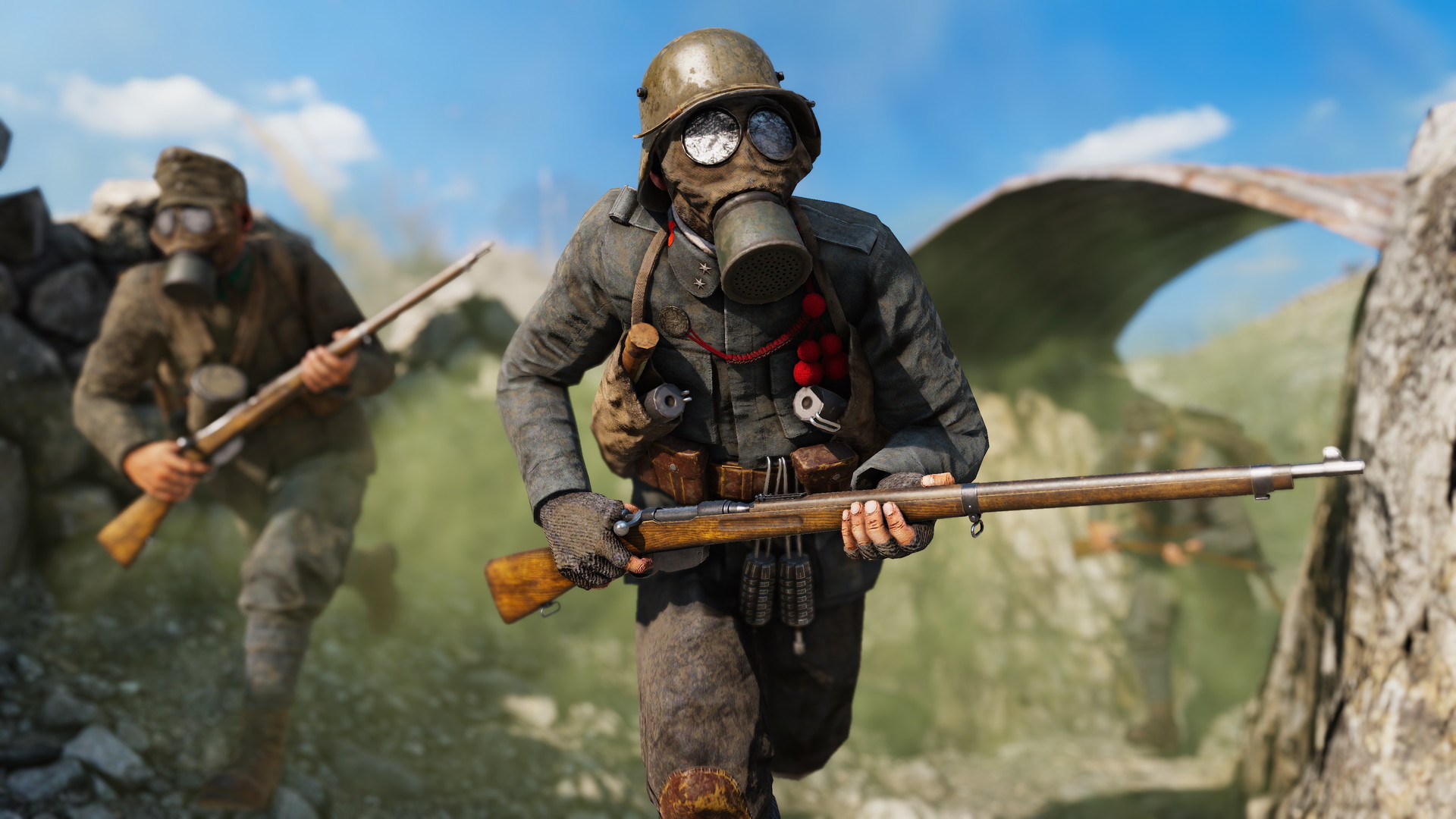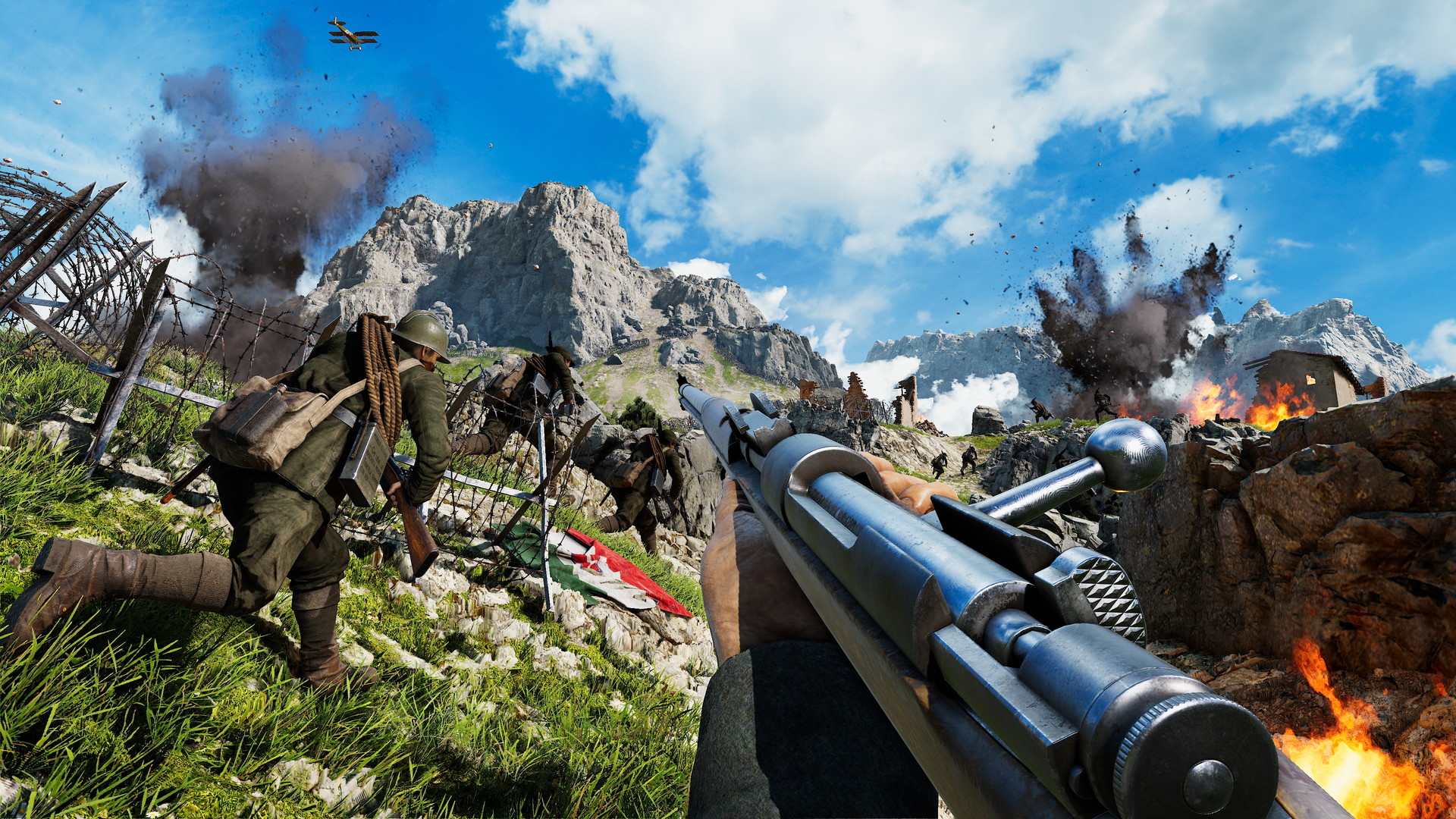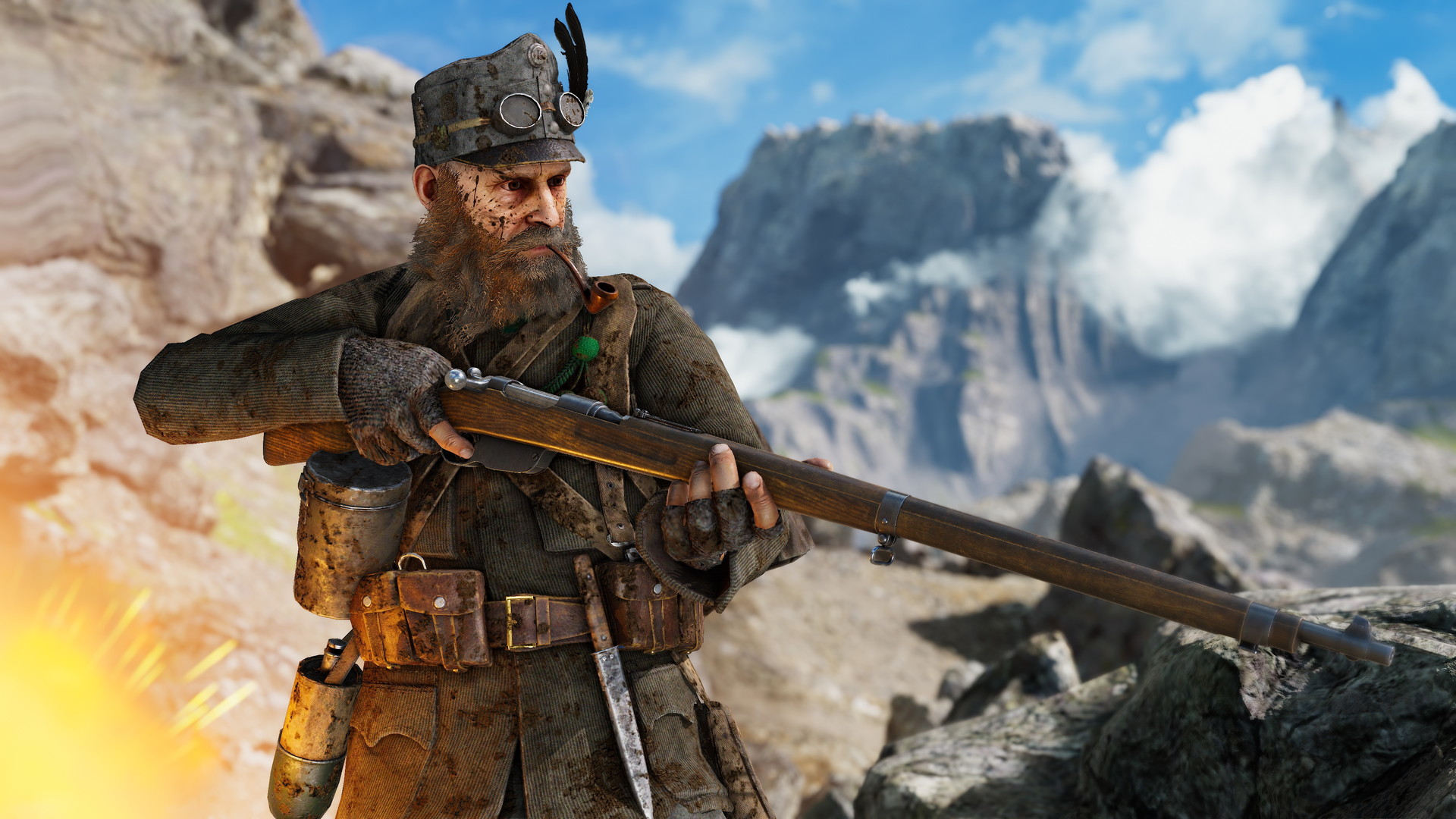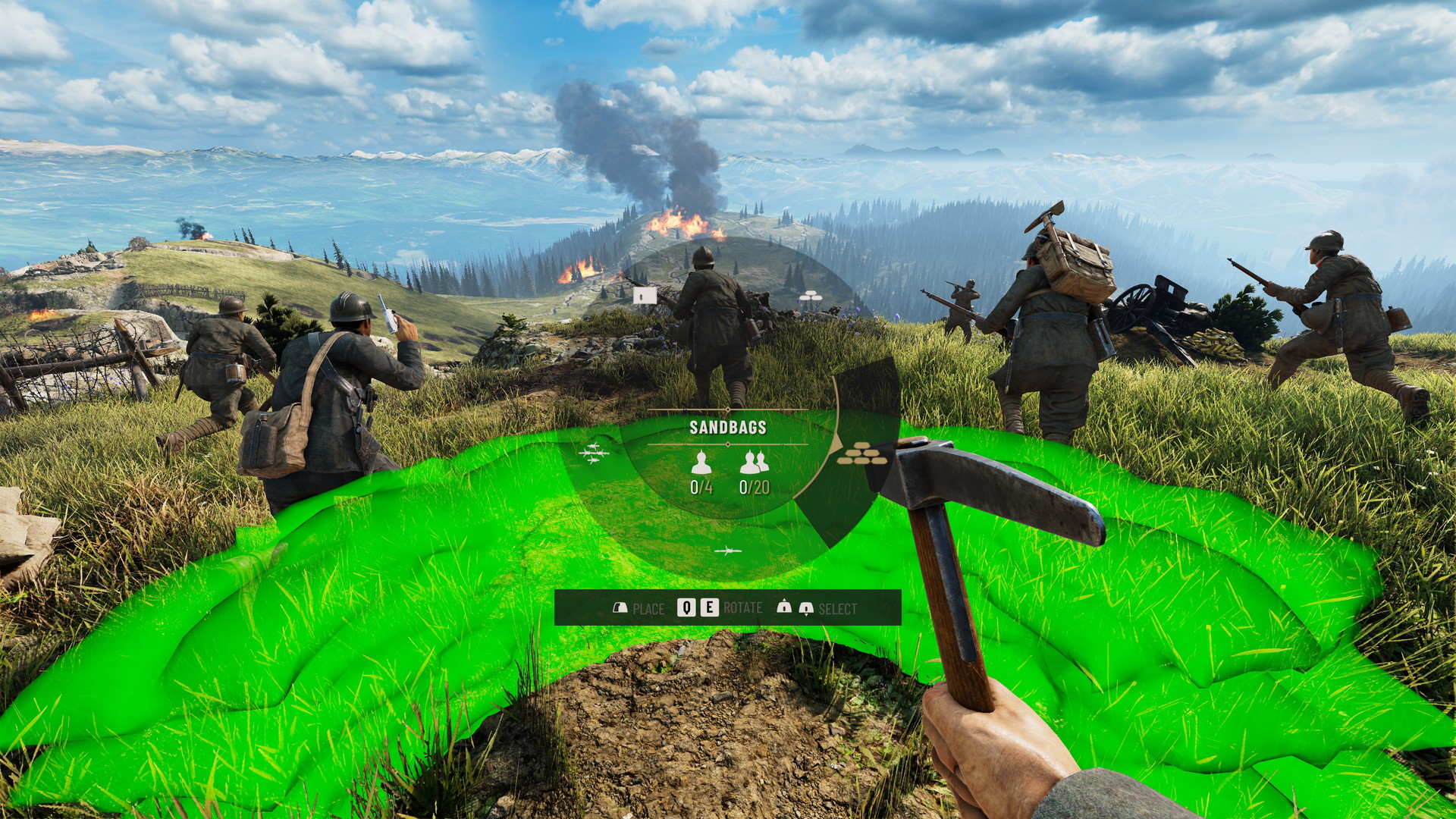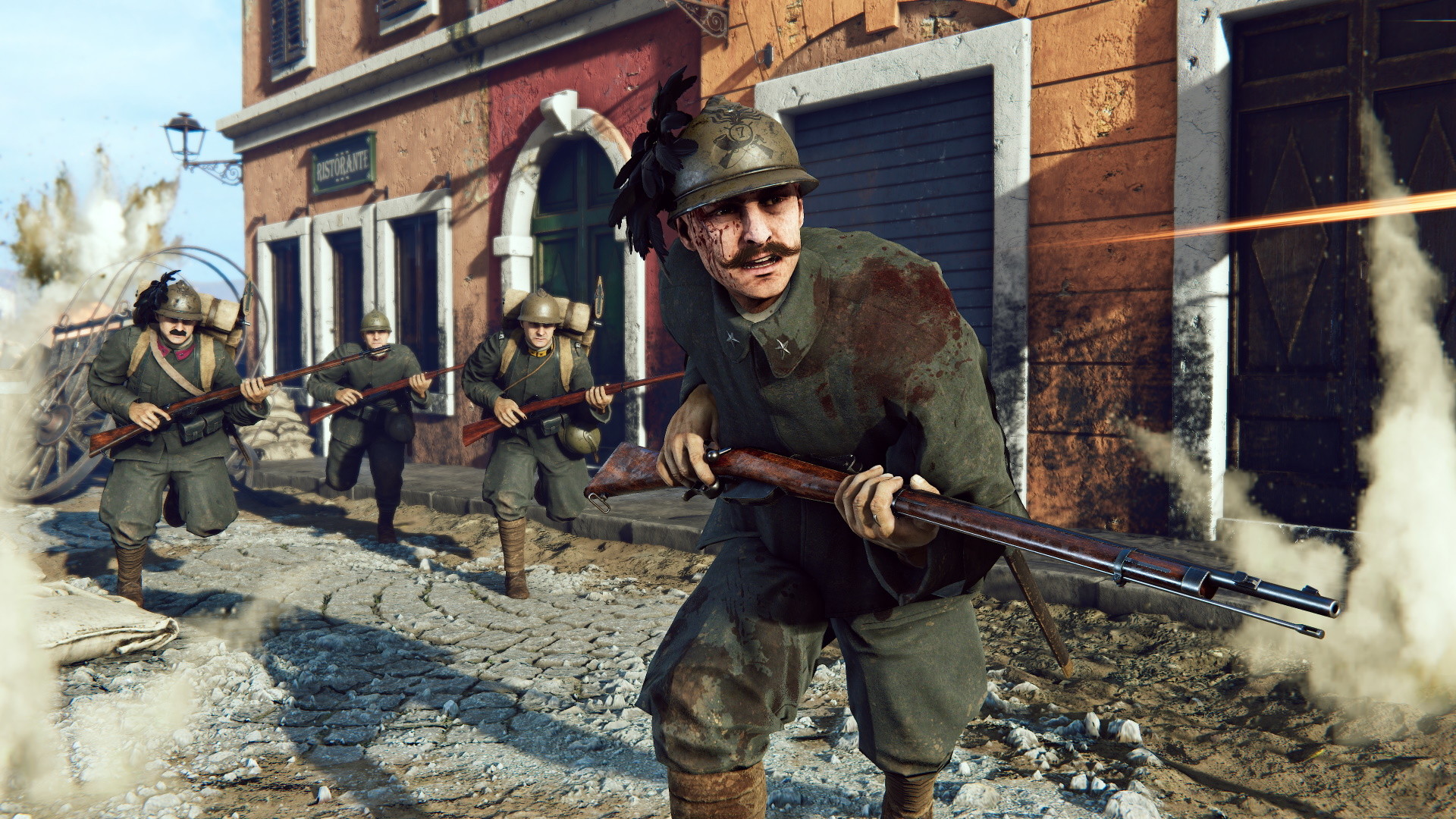World War One expands to the mountains of the Italian Front - beautiful but deadly in equal measure. Inspired by the two year struggle for control of the Isonzo river valley and the Alps during World War One, Isonzo elevates the WW1 Games Series, figuratively and literally.
From the makers of Verdun and Tannenberg …
The new Offensive game mode puts you right in the middle of key historical offensives on the Italian Front. Lead the charge across stunning Italian landscapes as you choose your path to victory - cut paths through barbed wire, flank your enemies by following mountain trails, or man a mortar to blast a way through. Shape a dynamic battlefield by laying sandbags and wire, placing ammo crates, deploying trench periscopes or sniper shields, and more.

Take part in historical offensives from the Sixth Battle of the Isonzo to the Strafexpedition. Reflecting the course of the actual battles, as the attackers advance the fighting will shift through vastly different landscapes within a single offensive: from hillside fortresses to mountain trenches and fierce urban combat on city streets. Everything is recreated based on research and field trips, from sound effects and uniforms down to the houses, vineyards and trenches you’ll be fighting over.
Call in support with a unique historically accurate flare system: flare guns can mark targets for artillery or biplane flybys, or different colored flares can be used to guide your team. Once the big guns have softened up the enemy, finish the job at close quarters with an Arditi dagger or mountaineer’s pickaxe. Man heavy machine guns, mortars and even mountain guns for more direct fire support.

Choose from six classes based on historical combat roles and build your loadout from a selection of weapons, equipment and perks linked to that class, giving flexibility and variety while staying grounded in what real soldiers might have carried. You’ll be operating wire cutters, bandaging yourself and wounded teammates, and blowing the whistle to start an assault. One shot can kill and even lighter injuries can lead to quickly bleeding out.
Being an effective soldier in Isonzo is not just about being a good marksman. Mastering the terrain is also key - the mountain can be a friend or foe. Learn how to navigate well to maintain cover and surprise your enemies or support your allies.
Finally… watch out for the dreaded poison gas. You’ve never experienced WW1 action quite like this!
Isonzo key features include:
More Games in the Authentic WW1 Game Series
Immerse yourself in more WW1 action with our other standalone titles Tannenberg and Verdun. Experience trench warfare on the Western Front in Verdun, or maneuver for control of key sectors in Tannenberg on the Eastern Front. These authentic WW1 shooters let players choose from a range of squads from across the war, as they fight for control of the ever-changing frontlines.
From the makers of Verdun and Tannenberg …
The new Offensive game mode puts you right in the middle of key historical offensives on the Italian Front. Lead the charge across stunning Italian landscapes as you choose your path to victory - cut paths through barbed wire, flank your enemies by following mountain trails, or man a mortar to blast a way through. Shape a dynamic battlefield by laying sandbags and wire, placing ammo crates, deploying trench periscopes or sniper shields, and more.

Take part in historical offensives from the Sixth Battle of the Isonzo to the Strafexpedition. Reflecting the course of the actual battles, as the attackers advance the fighting will shift through vastly different landscapes within a single offensive: from hillside fortresses to mountain trenches and fierce urban combat on city streets. Everything is recreated based on research and field trips, from sound effects and uniforms down to the houses, vineyards and trenches you’ll be fighting over.

Call in support with a unique historically accurate flare system: flare guns can mark targets for artillery or biplane flybys, or different colored flares can be used to guide your team. Once the big guns have softened up the enemy, finish the job at close quarters with an Arditi dagger or mountaineer’s pickaxe. Man heavy machine guns, mortars and even mountain guns for more direct fire support.

Choose from six classes based on historical combat roles and build your loadout from a selection of weapons, equipment and perks linked to that class, giving flexibility and variety while staying grounded in what real soldiers might have carried. You’ll be operating wire cutters, bandaging yourself and wounded teammates, and blowing the whistle to start an assault. One shot can kill and even lighter injuries can lead to quickly bleeding out.
Being an effective soldier in Isonzo is not just about being a good marksman. Mastering the terrain is also key - the mountain can be a friend or foe. Learn how to navigate well to maintain cover and surprise your enemies or support your allies.
Finally… watch out for the dreaded poison gas. You’ve never experienced WW1 action quite like this!
Isonzo key features include:
- Mountain warfare: Assaulting mountain fortifications, battling through ruined towns, and fording rivers are just a few of the challenges you’ll face as you fight your way through numerous enemy positions
- Tactical multiplayer FPS: Choose your role and loadout carefully to survive this high altitude combat - play a sniper to pick off the enemy engineers before they can cut your wire, use rifle grenades to clear enemy machine guns, and much more
- World War One Gameplay: Historical Offensive game mode based on real battles and focused on the unique challenges of Alpine warfare. Fight with 30+ WW1 weapons, poisonous gas attacks, and intense artillery barrages
- Build for victory: Place your own wire, sandbags, trench periscopes, and more! Whether you’re digging in or on the attack, shaping the battlefield to your advantage will be key to victory
- Faces of war: Make every class your own by picking from a variety of historically class-appropriate uniforms, accessories and headgear. As a finishing touch, you can even pick your mustache from several famous period-accurate styles!
- Authentic WW1 atmosphere: Accuracy in everything from maps and weaponry to music and the uniforms – fight for the Kingdom of Italy or the Austro-Hungarian Dual Monarchy

More Games in the Authentic WW1 Game Series
Immerse yourself in more WW1 action with our other standalone titles Tannenberg and Verdun. Experience trench warfare on the Western Front in Verdun, or maneuver for control of key sectors in Tannenberg on the Eastern Front. These authentic WW1 shooters let players choose from a range of squads from across the war, as they fight for control of the ever-changing frontlines.
Dev Blog #18 - Call in the big guns!

Artillery such as this 149mm Italian piece also appears on the battlefield in Isonzo, as sabotage objectives or incidental detail. There are also the mortars which are functional weapons!
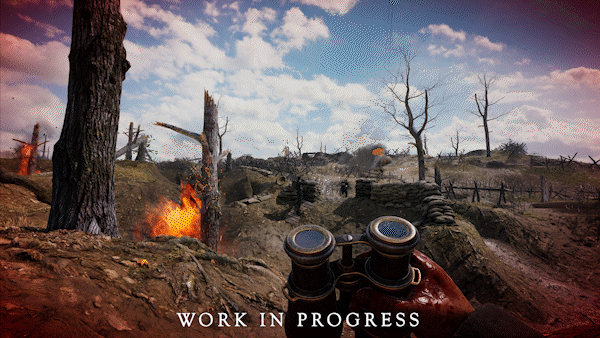
A mortar impact from the most basic artillery call-in option.
Having good cover will protect infantry from artillery shells, so artillery call-ins will be less effective when targeted on trenches, ruined buildings, and areas with a lot of large rocks. Of course theres always the chance that a shell will land in a trench, with predictably gruesome results. In addition, because of the rocky landscapes in Isonzo, artillery will cause stone fragments to fly around and therefore has a larger range in which players are wounded.
Heavy artillery
The third artillery call-in option is the heavy artillery. This represents the super-heavy siege howitzers used by each side, with their enormous shells. The Austro-Hungarian koda 30.5 cm Mrser M.11 fired 305mm shells, while the Italian Mortaio da 210/8 D.S. uses 210mm. Only a few shells are fired but the power of them is enormous.

Left: Austro-Hungarian koda 30.5 cm Mrser M.11, Right: Italian Mortaio da 210/8 D.S.
The trend at the start of WW1 had been towards lighter, fast firing artillery pieces. These were devastating against enemy troops in more open ground, but as the war of movement ground to a halt and trench networks were constructed, the militaries involved quickly realized they had a need for heavier guns which could penetrate fortifications. You can expect the super-heavy shells of this call-in option to be more effective even against fortified positions like trenches or ruins - even if they dont kill everyone present, injury and suppression effects can make them vulnerable to an infantry charge.

A super-heavy shell from a siege mortar.
Barrages
The last two options for artillery call-ins are the barrage, and the creeping barrage. The barrage calls in 10 heavy shells on an area, which will almost certainly eliminate any defenders outside of cover in a larger area than the earlier call-in options. The creeping barrage fires 16 shells, but has a special feature - it is aimed, and the shell impact locations will gradually move from the starting point in a direction specified by the officer calling it in.

Youll choose the direction of the creeping barrage as you call it in, using the flare location as the starting point.
Creeping barrages were a technique developed to allow friendly infantry to advance behind the cover of the barrage, so that defenders would have to stay in cover until the attackers were almost on top of them. They were creeping because they had to move forward slowly, at the rate of an advancing infantryman. This was a complicated business to organize with WW1 technology and didnt always come off correctly, but when it did work out it was very effective.

A 6x speed version of a creeping barrage in action. These can be truly devastating
As a final note on artillery barrages, remember that officers targeting a second flare on a location will boost the next call-in aimed there, which for artillery means more shells fired. This has a greater impact on the two barrages, with 25% more shells coming down during a boosted creeping barrage.

Bombardment on the Carso with rocks flying about

Particles in action on the wooded slope of the Gorizia map. The leaves at the start of the GIF are particles.
 Italian Albini & Figlio binoculars.
Italian Albini & Figlio binoculars.
Binoculars (also called field glasses) were in huge demand during WW1 with many officers buying privately when they could. Not only useful in ground combat, they were also vital for sailors to spot other ships or submarines, and used for aerial observation from balloons. In Isonzo they are useful for observing the battlefield, and you can also spot enemies which marks them on the mini-map for your entire team.
Artillery
Artillery must feature heavily in any WW1 game worthy of the name. It is generally considered to be the largest cause of military casualties during the war - perhaps more than 50% - and it affected tactics and strategy alike. Since Verdun artillery has been a gameplay feature of the WW1 Game Series. Then it was called in by squad leaders, while in Isonzo it is the Officer class who handle support requests, as detailed in a previous Isonzo Intel.
Artillery such as this 149mm Italian piece also appears on the battlefield in Isonzo, as sabotage objectives or incidental detail. There are also the mortars which are functional weapons!
Types of Artillery Support
Every support category in Isonzo has five different options, ranging from short cooldown to long cooldown. For the artillery, mortars and field guns are the two shortest cooldown options. They fire four shells (medium for mortars, heavy for field guns) at the targeted flare marker. As youd expect, they will kill, injure and suppress nearby soldiers, with the heavier field gun shells having a larger area of effect.
A mortar impact from the most basic artillery call-in option.
Having good cover will protect infantry from artillery shells, so artillery call-ins will be less effective when targeted on trenches, ruined buildings, and areas with a lot of large rocks. Of course theres always the chance that a shell will land in a trench, with predictably gruesome results. In addition, because of the rocky landscapes in Isonzo, artillery will cause stone fragments to fly around and therefore has a larger range in which players are wounded.
Heavy artillery
The third artillery call-in option is the heavy artillery. This represents the super-heavy siege howitzers used by each side, with their enormous shells. The Austro-Hungarian koda 30.5 cm Mrser M.11 fired 305mm shells, while the Italian Mortaio da 210/8 D.S. uses 210mm. Only a few shells are fired but the power of them is enormous.

Left: Austro-Hungarian koda 30.5 cm Mrser M.11, Right: Italian Mortaio da 210/8 D.S.
The trend at the start of WW1 had been towards lighter, fast firing artillery pieces. These were devastating against enemy troops in more open ground, but as the war of movement ground to a halt and trench networks were constructed, the militaries involved quickly realized they had a need for heavier guns which could penetrate fortifications. You can expect the super-heavy shells of this call-in option to be more effective even against fortified positions like trenches or ruins - even if they dont kill everyone present, injury and suppression effects can make them vulnerable to an infantry charge.

A super-heavy shell from a siege mortar.
Barrages
The last two options for artillery call-ins are the barrage, and the creeping barrage. The barrage calls in 10 heavy shells on an area, which will almost certainly eliminate any defenders outside of cover in a larger area than the earlier call-in options. The creeping barrage fires 16 shells, but has a special feature - it is aimed, and the shell impact locations will gradually move from the starting point in a direction specified by the officer calling it in.

Youll choose the direction of the creeping barrage as you call it in, using the flare location as the starting point.
Creeping barrages were a technique developed to allow friendly infantry to advance behind the cover of the barrage, so that defenders would have to stay in cover until the attackers were almost on top of them. They were creeping because they had to move forward slowly, at the rate of an advancing infantryman. This was a complicated business to organize with WW1 technology and didnt always come off correctly, but when it did work out it was very effective.

A 6x speed version of a creeping barrage in action. These can be truly devastating
As a final note on artillery barrages, remember that officers targeting a second flare on a location will boost the next call-in aimed there, which for artillery means more shells fired. This has a greater impact on the two barrages, with 25% more shells coming down during a boosted creeping barrage.

Bombardment on the Carso with rocks flying about
Particles
We spent a lot of time on making artillery impacts feel powerful, and our particle system plays a large role in that. The dirt thrown up, the smoke left behind, its all particles. And its not only useful for explosions! Weve used it for tree leaves fluttering through the air, ambient dust to capture the feel of certain environments and weather conditions, and much more.
Particles in action on the wooded slope of the Gorizia map. The leaves at the start of the GIF are particles.
Albini & Figlio Binoculars
The Italian officers and mountaineers in Isonzo can make use of these Albini & Figlio binoculars for observation and spotting - often a good idea before calling for artillery support! You dont want to waste your creeping barrage on a section of trench with only a handful of enemies after all Italian Albini & Figlio binoculars.
Italian Albini & Figlio binoculars.Binoculars (also called field glasses) were in huge demand during WW1 with many officers buying privately when they could. Not only useful in ground combat, they were also vital for sailors to spot other ships or submarines, and used for aerial observation from balloons. In Isonzo they are useful for observing the battlefield, and you can also spot enemies which marks them on the mini-map for your entire team.
More call-ins to come!
There are two more categories of call-in that officers can utilize, the feared Chemical Regiment and the dashing Aviation Corps. Well get to those in future dev blogs. See you next time![ 2022-05-13 21:50:46 CET ] [Original Post]
Minimum Setup
- OS: Requires a 64-bit processor and operating system
- Processor: Intel Core 2 Quad Q9550Memory: 4 GB RAM
- Memory: 4 GB RAM
- Graphics: NVIDIA GeForce GT 640
- Storage: 20 GB available space
Recommended Setup
- OS: Requires a 64-bit processor and operating system
- Processor: Intel i7-4770Memory: 16 GB RAM
- Graphics: NVIDIA GeForce GTX 1050
- Storage: 20 GB available space
GAMEBILLET
[ 6425 ]
GAMERSGATE
[ 3784 ]
MacGamestore
[ 2906 ]
FANATICAL BUNDLES
HUMBLE BUNDLES
by buying games/dlcs from affiliate links you are supporting tuxDB

